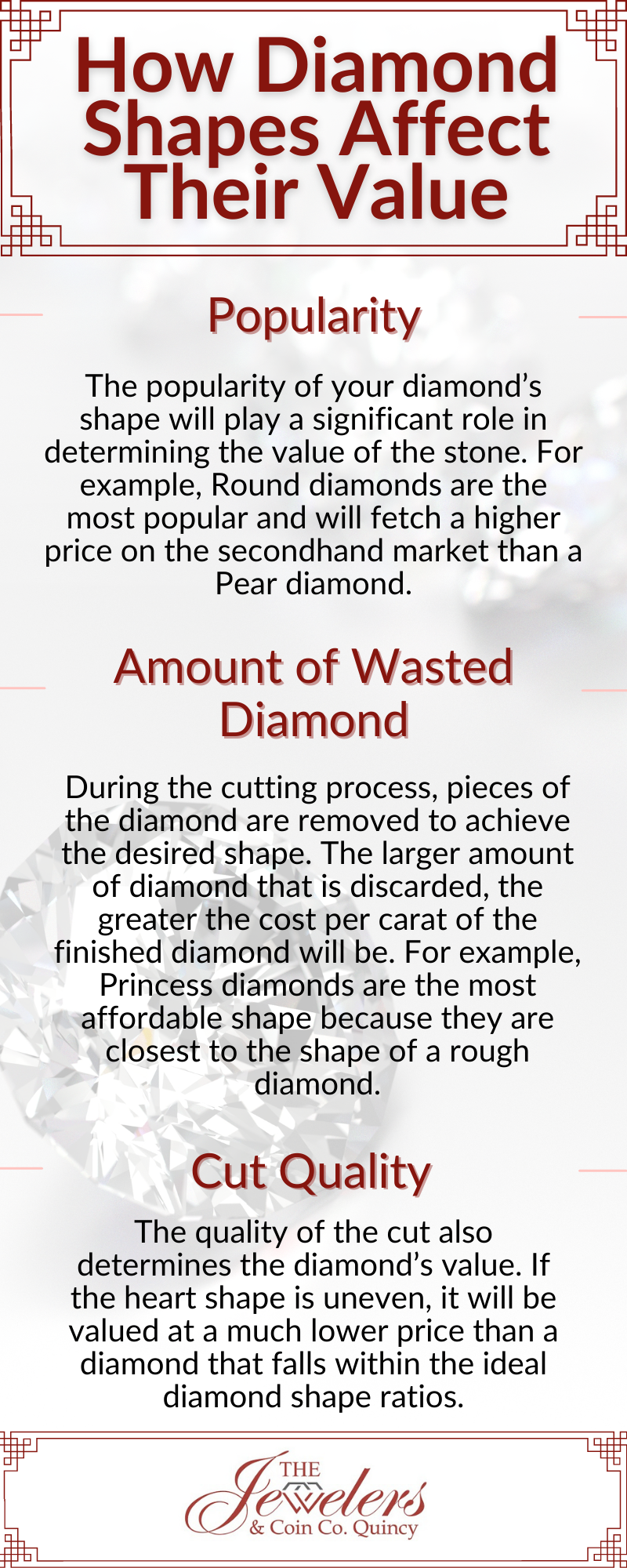“A diamond is forever.”
“Diamonds are a girl’s best friend.”
“Diamond in the rough.”
“Coal under extreme pressure makes diamonds.”
Besides the mention of diamonds, what do these statements have in common? They are all pointing out the value and timeless quality of diamonds. Most people know that diamonds are bought and sold at a higher price than other gemstones, but not everyone knows that the shape, often called “cut,” of diamonds affects their price.
Before you learn exactly how diamond shapes affect value, it’s essential to clarify some definitions. The word “cut” is sometimes used interchangeably within the diamond market, especially conversationally by people who are buying and selling diamonds of their own rather than selling on behalf of a jeweler or retailer. When talking about diamonds, you might hear the phrase “diamond cut grade,” “cut quality,” “excellent/good/fair/poor cut.” This specific use of the word “cut” is not referring to the shape of a diamond; rather, it’s about how the stone is faceted to reflect light. A “brilliant cut” diamond isn’t just one available in one shape, but rather a form of faceting that can be applied to any diamond to make it especially sparkly. “Brilliant cut” is not to be confused with “round brilliant,” which is a specific type of diamond shape.
Still following? We know it can be confusing, but stay with us — it gets easier from here.
What Shapes Do Diamonds Come In?
While the cut grade of a diamond does affect its value, its shape is more often than not what the jeweler sees first.
Whether you’re buying or selling, or exchanging diamonds in Boston, whether loose or as part of a diamond ring or other piece, you are going to be met with a variety of options when it comes to how the actual stone looks. This is because there are as many ways to cut a diamond just as there are ways to design engagement rings — unlimited, depending only on your imagination. However, there are industry standards that are especially popular. The ten diamond cuts that are the most common are “Round Brilliant,” which is considered a standard cut, and nine other cuts considered “fancy cuts:”
- Emerald
- Cushion
- Oval
- Heart
- Radiant
- Marquise
- Princess
- Pear
- Asscher
The overwhelmingly popular Round Brilliant is easy to spot, and it’s beloved for good reason. The circular shape enhances the depth appearance of the diamond and really stands out on engagement rings. The name “Brilliant” should also tip you off that the default cut grade of this diamond makes it sparkle and stand out, with more facets than an average diamond.
A few more of these names are also as literal as they sound. Pear cut, Oval cut, and Heart cut diamonds are shaped like pear/teardrops, ovals, and hearts, respectively. However, naming the cuts of diamonds isn’t always as easy as taking a quick glance:

It may be tough to spot the difference between, say, an Asscher cut and a Radiant cut. However, a trained jeweler can tell the difference easily and will price the diamond accordingly.
What’s My Diamond Worth Based on Its Shape?

So when you’ve figured out the shape of diamond you’ll be buying or own a diamond you’re interested in selling, how do you know the value of the diamond? Essentially, the larger percentage of the rough diamond that is cut away during the creation process, the more money it’s worth.
For example, Princess cut diamonds are known to be more affordable. This is because this type of diamond uses closer to 80% of the diamond’s carat weight, and only 20% of the rest of the diamond has to be cut away. Meanwhile, with a Round Brilliant cut, more of the diamond’s carat weight is lost in the cutting process, meaning it will cost a buyer more as there is a higher price per carat.
In other words, the more finicky the diamond is to cut, the more it will be likely to cost. Along with the Princess cut, other lower-waste and thus lower-cost fancy cuts include the Asscher, Emerald, and Cushion cuts. Another factor where diamonds’ shapes affect their value lies in their popularity. Sometimes, less common cuts are valued more for their originality, or alternatively, high-demand shapes will be marked up accordingly, depending on the market.
What’s My Diamond Worth Based On Its Cut Quality?
While it may not be the first thing you immediately notice about a diamond ring, jewelers do place significant importance on cut quality, which we defined earlier. Selling your diamonds will almost certainly involve a jeweler taking a very close look at the depth and width of the cuts made in the stone and assessing where the diamond is on the scale of “Poor” all the way up to “Excellent” cut quality. This scale is more straightforward than evaluating diamonds based on their shape — it’s simply a fact that the higher cut quality a diamond is, the more its value increases.
How Do I Truly Know the Value of My Diamond?
Once you speak the language, it can be easier to get a good feeling for a ballpark value for your diamond(s). However, it is ultimately impossible for most people to take a guess at what their diamonds will be worth and get it right every time without the advanced knowledge and special skills that jewelers bring to the table. That’s why it’s best to have your diamonds examined by a professional, especially if you’re trying to sell them for cash. Consider selling your diamonds in Boston, MA, and reach out if you’re interested in investing in — or gaining income from — a piece of “forever.”
